Cycling along the River Rhine, through Switzerland, Germany, and France (160 miles in 7 days).
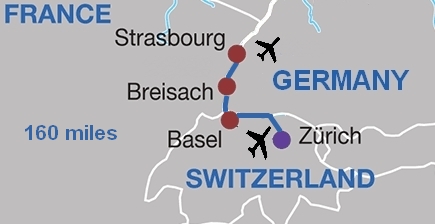 The theme of this ride has to be ‘chocolate’; I started the cacao experience in Switzerland
and finished it in France. My journey begins in Zürich Switzerland and follows the River ‘Limmat’,
and 'Aare', later connecting to the Rhine and into Germany and finishing at ‘Rust’. It
was a an absolute delight cycling through the Swiss and German medieval towns.
Last year I rode along the river Danube and discovered complications transporting my bike
across to Austria. Keeping a touring bike (and bag) under the weight limit for the flight
was difficult, but the biggest issue was actually transporting just the bike bag (easy if
it were a circular route) from start to finish of the ride. I wanted to ride in Europe
again, but without last year’s hassle. So this time, I’m using the ‘Dahon’ folding bike, as
it can go as normal luggage (and you carry the bike bag), but even though the trip was meticulously
prepared, things didn’t go completely to plan!
The theme of this ride has to be ‘chocolate’; I started the cacao experience in Switzerland
and finished it in France. My journey begins in Zürich Switzerland and follows the River ‘Limmat’,
and 'Aare', later connecting to the Rhine and into Germany and finishing at ‘Rust’. It
was a an absolute delight cycling through the Swiss and German medieval towns.
Last year I rode along the river Danube and discovered complications transporting my bike
across to Austria. Keeping a touring bike (and bag) under the weight limit for the flight
was difficult, but the biggest issue was actually transporting just the bike bag (easy if
it were a circular route) from start to finish of the ride. I wanted to ride in Europe
again, but without last year’s hassle. So this time, I’m using the ‘Dahon’ folding bike, as
it can go as normal luggage (and you carry the bike bag), but even though the trip was meticulously
prepared, things didn’t go completely to plan!
Day 1- Newport to Zürich (flying BA)
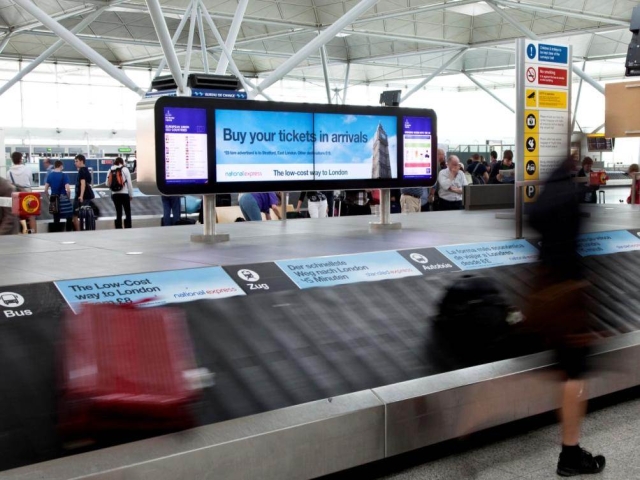 The bike had gone through the oversize luggage gate at Heathrow, and that is where
I expected it to come out at Zürich, but imagine my horror when I saw it come down a
steep ramp, where it clonked onto the carousel belt with other luggage thrown on top
of it. I picked it off the conveyer belt and headed straight to the information desk
to complain (bearing in mind this bag had three ‘Fragile’ labels pinned to it). The
lady said “where’s the damage?” I explained to the lady- a cycle is in the bag and it
could be damaged. “I can’t possibly do anything until I see any damage”. So I put the
bike together in front of her nose, luckily there wasn’t any damage to the bike, but
the bag was ripped to shreds. She commented, “the belt could not have done this damage”
and suggested it must have been ripped before transit. After some posturing on both
sides she agreed to allow me to fill in a damage claim form.
The bike had gone through the oversize luggage gate at Heathrow, and that is where
I expected it to come out at Zürich, but imagine my horror when I saw it come down a
steep ramp, where it clonked onto the carousel belt with other luggage thrown on top
of it. I picked it off the conveyer belt and headed straight to the information desk
to complain (bearing in mind this bag had three ‘Fragile’ labels pinned to it). The
lady said “where’s the damage?” I explained to the lady- a cycle is in the bag and it
could be damaged. “I can’t possibly do anything until I see any damage”. So I put the
bike together in front of her nose, luckily there wasn’t any damage to the bike, but
the bag was ripped to shreds. She commented, “the belt could not have done this damage”
and suggested it must have been ripped before transit. After some posturing on both
sides she agreed to allow me to fill in a damage claim form.
The train from Zürich Flughafen (airport) went straight into Zürich central, and then it was a short ride to the accommodation. Despite the ripped bag, I had a ‘wow’ experience on the train to Zürich. For a brief moment you can see the snow capped Alps, this really perked me up. I was staying in a cut price apartment to keep the price down, with shared toilets and showers. I’ve done this before and wasn’t impressed, so I don’t know why I booked it again (ahh yes, it was the price, hotel prices around Zürich are stupid, but after a hidden ‘service’ charge, I could have stayed in a hotel)?
Day 2- Lake Zürich (20 miles)
 Today, I intended to circumnavigate the lake, but didn’t feel well at all; a mystery
bug. I tried to sleep it off and awoke midday, I dragged myself out of bed and set off
under a cold leaden sky, but still
felt rough. Riding through the suburbs, the pleasant perfume of many ‘jasmine trees’
overpowered the olfactory receptors, suddenly the smell of chocolate set my mouth
alight with expectation. So what better way to make me feel better than a visit to a
chocolate factory? If ever you wondered what ‘Hansel & Gretel’ saw on that enchanted
cottage, a visit to the ‘Lindt’ chocolate factory shop will completely satisfy your
curiosity and lust for the dark gold. Though, after consuming some choccey treats,
I may have added to my feeble disposition.
Today, I intended to circumnavigate the lake, but didn’t feel well at all; a mystery
bug. I tried to sleep it off and awoke midday, I dragged myself out of bed and set off
under a cold leaden sky, but still
felt rough. Riding through the suburbs, the pleasant perfume of many ‘jasmine trees’
overpowered the olfactory receptors, suddenly the smell of chocolate set my mouth
alight with expectation. So what better way to make me feel better than a visit to a
chocolate factory? If ever you wondered what ‘Hansel & Gretel’ saw on that enchanted
cottage, a visit to the ‘Lindt’ chocolate factory shop will completely satisfy your
curiosity and lust for the dark gold. Though, after consuming some choccey treats,
I may have added to my feeble disposition.
I continued to ride on the ‘Seestrasse’ (the road surrounding the lake), but it wasn’t as picturess as I imagined, you only catch glimpses of the lake. The best views of the lake were taken up by properties along the bank, so I could have been riding on any road anywhere. I managed to get to ‘Horgen’ before sitting on the quayside feeling thoroughly sick, so I waited to catch the ferry back to Zürich. Along come one of the renowned steam paddle ships; ‘Stadt Zürich’. Stadt Zürich is the older of two remaining steam ships (with an oil fired boiler) running on Lake Zürich. I boarded the ship and sat outside to catch the air as it wobbled ‘to and fro’ progressing along the lake. Normally, I can tolerate the smell of hot steam engine oil, but on this occasion it pushed me over the edge, and I vomited over the side (much to both the disgust and amusement of some passengers). With my head held in shame, I disembarked this one hundred year old paddle steamer at Zürich, and rode back to my overpriced ‘doss-house’ and went straight back to bed. This meant I missed one of the jewels on the shore of Lake Zürich; Rapperswil -Jona, a beautiful medieval area with a castle. Another time, maybe?
Day 3- Zürich to Bad Säckingen (45 miles)
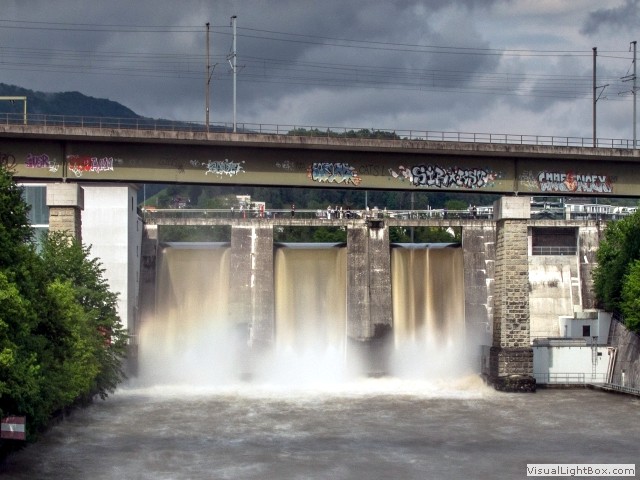 After yesterday, I was dubious about cycling today, but on the contrary, I couldn’t wait to
leave Zürich. For the first twelve miles the rain spat at me, as I rode along cycle paths
adjacent to industrial roads, not pleasant in the slightest. Towards ‘Wettingen’ it became
slightly more interesting when I crossed the river Limmat, to the right was the first of
many hydroelectric power stations and to the left was the paradoxical early nineteenth
century wooden bridge, built to connect the monastery peninsula of Wettingen with
Neuenhof. I crossed over the river Limmat into the spa town of Baden, its hot mineral
springs have been famed since at least the Roman era. The medieval buildings were a
delight to ride through and the town is full of museums including a ‘Teddybaer’ (teddybear)
museum. Progressing through ‘Obersiggenthal’ it’s quite built up and I had to cut
some of the river hairpin bends out of the route to keep the overall millage down, this
caused loss of sight of the river until ‘Bottstein’, when the river re-emerged it was the river Aare (the river
Limmat joined the river Aare a few miles back).
After yesterday, I was dubious about cycling today, but on the contrary, I couldn’t wait to
leave Zürich. For the first twelve miles the rain spat at me, as I rode along cycle paths
adjacent to industrial roads, not pleasant in the slightest. Towards ‘Wettingen’ it became
slightly more interesting when I crossed the river Limmat, to the right was the first of
many hydroelectric power stations and to the left was the paradoxical early nineteenth
century wooden bridge, built to connect the monastery peninsula of Wettingen with
Neuenhof. I crossed over the river Limmat into the spa town of Baden, its hot mineral
springs have been famed since at least the Roman era. The medieval buildings were a
delight to ride through and the town is full of museums including a ‘Teddybaer’ (teddybear)
museum. Progressing through ‘Obersiggenthal’ it’s quite built up and I had to cut
some of the river hairpin bends out of the route to keep the overall millage down, this
caused loss of sight of the river until ‘Bottstein’, when the river re-emerged it was the river Aare (the river
Limmat joined the river Aare a few miles back).
At the confluence of the Aare and Rhine
rivers at last I’m in the countryside following the Rhine in westerly direction on the
Swiss side. After turning right on a farm road I catch sight of a bunker, then another
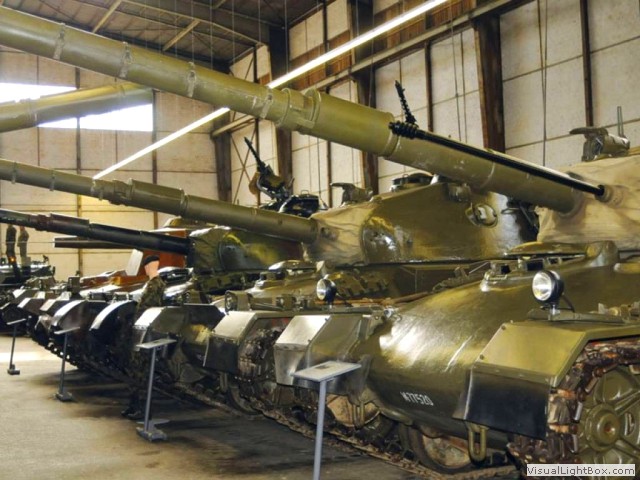 about a mile on. At about 28 miles from Zürich,
I came across the Swiss Military Museum (Schweizerisches Militärmuseum),
this place is massive and covers buildings and vehicles used by the Swiss Army, it was
CHF 15 (which is about £11) to enter. I spent an hour there, but couldn’t do it
justice and had to move on, passing the Leibstadt Nuclear Power Plant and yet another
bunker. The cycle path now follows the single railway line until I finally cross the
Rhine into Germany at Laufenburg, and then the path turns to parallel the river passing
the German equivalent of riverside holiday homes until I reach Bad Säckingen and the
Hotel Sankt (St) Fridolin. The hotel was modest in price, but it was great, it had an
honesty bar with fantastic local wine from ‘Basel’. Bad Säckingen is located at the
southern end of the Black Forest and Switzerland is just a few minutes walk away,
crossing the Rhine on a lovely old wooden bridge. I had to eat and walked around
the town, but everything wasn’t open until 1730, I did a full circle and ate at my original hotel.
about a mile on. At about 28 miles from Zürich,
I came across the Swiss Military Museum (Schweizerisches Militärmuseum),
this place is massive and covers buildings and vehicles used by the Swiss Army, it was
CHF 15 (which is about £11) to enter. I spent an hour there, but couldn’t do it
justice and had to move on, passing the Leibstadt Nuclear Power Plant and yet another
bunker. The cycle path now follows the single railway line until I finally cross the
Rhine into Germany at Laufenburg, and then the path turns to parallel the river passing
the German equivalent of riverside holiday homes until I reach Bad Säckingen and the
Hotel Sankt (St) Fridolin. The hotel was modest in price, but it was great, it had an
honesty bar with fantastic local wine from ‘Basel’. Bad Säckingen is located at the
southern end of the Black Forest and Switzerland is just a few minutes walk away,
crossing the Rhine on a lovely old wooden bridge. I had to eat and walked around
the town, but everything wasn’t open until 1730, I did a full circle and ate at my original hotel.
Day 4- Bad Säckingen to Neuenburg am Rhein (46 miles)
I watched the heavy rain thump the windows while having had a great breakfast in this
excellent little hotel. The weather man said the rain will stop at 10.00 and give or
take five minutes, it did. The air smelt of ozone when I left the place straight onto a
main road, most of the main roads had a marked off cycle lane- this one did not. I
feel I must have plotted this bit of the route wrong, the road was too busy and
 dangerous, though in fairness the heavy goods vehicles and cars were considerate and
passed wide, but I still felt vulnerable. I diverted off the main road through
‘Schwörstadt’ and was stopped by police to allow the air ambulance to land (I
hoped this wasn’t an omen). At ‘Beuggen’ I came off the main road and went through
the arch of ‘Schloss Beuggen’, a thirteenth century mansion and estate. The origins
of Beuggen estate are unknown, but a Knight called ‘Mangold’ was a documented
owner. I rode past another hydroelectric power station; Wasserkraftwerk Rheinfelden,
and I wondered since the structure has to span two countries; who owns the rights to the power generated?
dangerous, though in fairness the heavy goods vehicles and cars were considerate and
passed wide, but I still felt vulnerable. I diverted off the main road through
‘Schwörstadt’ and was stopped by police to allow the air ambulance to land (I
hoped this wasn’t an omen). At ‘Beuggen’ I came off the main road and went through
the arch of ‘Schloss Beuggen’, a thirteenth century mansion and estate. The origins
of Beuggen estate are unknown, but a Knight called ‘Mangold’ was a documented
owner. I rode past another hydroelectric power station; Wasserkraftwerk Rheinfelden,
and I wondered since the structure has to span two countries; who owns the rights to the power generated?
I reached the town of ‘Rheinfelden (Baden)’ where there was a medieval bridge crossing into the Gothic Swiss town of ‘Rheinfelden’. The entire old town of Rheinfelden is designated as part of a Swiss heritage site. The river was raging through the multiple buttress bridge as I sat there and had a coffee in the ‘Museum Haus Salmegg’. The present-day Salmegg house was built in 1825 on the foundations of the fortification of the former bridgehead. At ‘Basel’ I rode along the side of the Rhine competing with hundreds of runners (no it wasn’t a race), it just seemed trendy to run along this part of the river. As I rode out the other side of Basel it became industrialised. Basel is where Switzerland, France and Germany's borders meet. I was soon out the other side and following the Rhine again on gravel tracks, monotonous gravel tracks with herds of mosquitoes. More often than not, the track diverted away from the river and around open cast gravel or sand quarries. It was boring and hard work, especially when it began to rain, slowing the progress down by a few mph. I finally arrived in 'Neuenburg am Rhein' and rolled to the hotel, well not strictly a hotel, but a guest house; Gastehaus Ursula Fehrenbach. You can’t go wrong with these places, they’re often family run businesses and give a more value for money stay. I ate at the number one ‘Tripadvisor ©' place; Hotel-Restaurant Gasthof Adler. I had roast chicken and fries, and I have to say it was very nice, but nevertheless, it was the most expensive chicken and chips I’d ever had. I had a walk around the town, it’s an unknown gem of a place, there’s a nice square surrounded by coffee shops spilling out into the centre, and the little town has loads of water features and sculptures. Later that night, I enjoyed a fantastic free show of thunder and lightning.
Day 5- Neuenburg am Rhein to Breisach (train) then to Rust (23 miles)
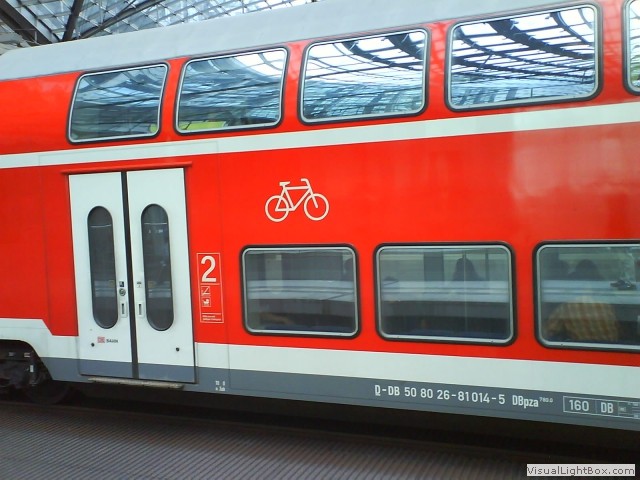 Unlike yesterday the weather man said it was heavy rain all day. I had hoped
that after breakfast a miracle would happen and the rain would stop, but it
didn’t, so I made the decision to cut today’s route in half by catching the train. The nearest station
to here was Müllheim (Baden), I soggily made my way there and to catch the train to
Breisach cutting twenty miles out of my ride. A French man began admiring my bike at
the station (he started speaking in French, then English when I replied, and said he
was from France, anyway), he asked me where I was going, and I told him- I finish my
ride at Rust where I catch the train to Strasburg airport. He said, “you’ll be lucky”,
and proceeded to tell me that the French trains are sporadically striking during May.
I replied, I should be okay, and then we talked about something else (this isn’t
just procrastination it’s relevant, just be patient). We could learn a lot from the
German trains, the British railway industry give us a 'potential' eight cycle
spaces per train, and they actually believe they’re doing you a favour. In
more ways than one, Europe has a different culture and they embrace the bike, I
counted twenty bikes on my train to Breisach.
Unlike yesterday the weather man said it was heavy rain all day. I had hoped
that after breakfast a miracle would happen and the rain would stop, but it
didn’t, so I made the decision to cut today’s route in half by catching the train. The nearest station
to here was Müllheim (Baden), I soggily made my way there and to catch the train to
Breisach cutting twenty miles out of my ride. A French man began admiring my bike at
the station (he started speaking in French, then English when I replied, and said he
was from France, anyway), he asked me where I was going, and I told him- I finish my
ride at Rust where I catch the train to Strasburg airport. He said, “you’ll be lucky”,
and proceeded to tell me that the French trains are sporadically striking during May.
I replied, I should be okay, and then we talked about something else (this isn’t
just procrastination it’s relevant, just be patient). We could learn a lot from the
German trains, the British railway industry give us a 'potential' eight cycle
spaces per train, and they actually believe they’re doing you a favour. In
more ways than one, Europe has a different culture and they embrace the bike, I
counted twenty bikes on my train to Breisach.
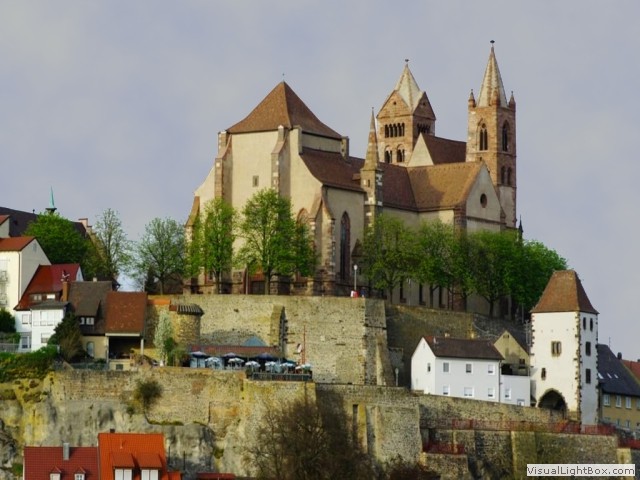 Breisach is now a railway terminus, but the line did cross the Rhine into France
prior to the start of the war, the bridge was destroyed in 1945 and never replaced.
The first thing that strikes you arriving in the town is the cathedral of ‘St.
Stephansmünster’ sitting on a high mound of land (a bit like Lincoln cathedral).
I was told the local museum is also worth a visit. Now it’s back on gravel tracks for mile
after mile, there were some small marinas or rowing clubs along the way, but on the
whole they were shut, the same story as yesterday. After sixteen miles from Breisach,
the track came away from the Rhine where I had a coffee at ‘Gasthaus zur Limburg’.
Occasionally I passed a walker or another cyclist, but generally this was a secluded
and boring trip. The one thing to say is; there are no potholes, none along the whole journey. It
began to rain heavily and I could see another marina in the distance, I put in an
effort to get there quickly. I had already taken the Garmin off the handlebars because
from previous experience it steams up in heavy rain. I made it to shelter and waited for the
rain to abate, when it did I put the Garmin back on the bars indicating there
Breisach is now a railway terminus, but the line did cross the Rhine into France
prior to the start of the war, the bridge was destroyed in 1945 and never replaced.
The first thing that strikes you arriving in the town is the cathedral of ‘St.
Stephansmünster’ sitting on a high mound of land (a bit like Lincoln cathedral).
I was told the local museum is also worth a visit. Now it’s back on gravel tracks for mile
after mile, there were some small marinas or rowing clubs along the way, but on the
whole they were shut, the same story as yesterday. After sixteen miles from Breisach,
the track came away from the Rhine where I had a coffee at ‘Gasthaus zur Limburg’.
Occasionally I passed a walker or another cyclist, but generally this was a secluded
and boring trip. The one thing to say is; there are no potholes, none along the whole journey. It
began to rain heavily and I could see another marina in the distance, I put in an
effort to get there quickly. I had already taken the Garmin off the handlebars because
from previous experience it steams up in heavy rain. I made it to shelter and waited for the
rain to abate, when it did I put the Garmin back on the bars indicating there
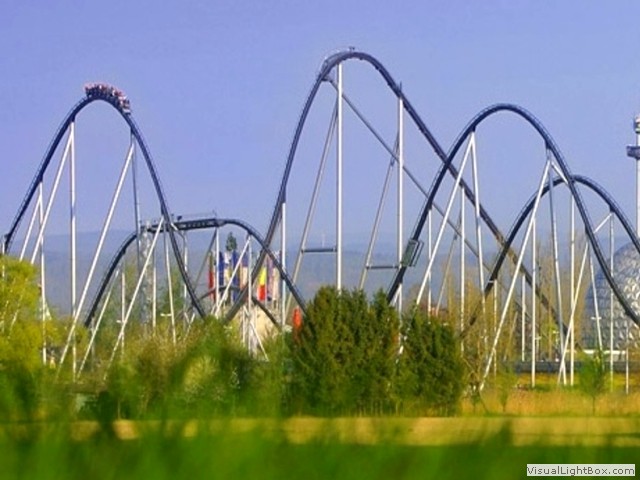 was a change of direction just behind me. The bottom line is; if I hadn’t sought
shelter where I did- I would have missed the direction change. I headed towards
‘Weisweil’ then ‘Rhienhausen’ on good separate cycle paths when the heavens
opened again. When I looked up I could see the massive ‘Blaues Feuer-
Timburcoaster’ (blue fire roller coaster) in the ‘Europa park. I rolled into
‘Rust’ soggy and cold.
was a change of direction just behind me. The bottom line is; if I hadn’t sought
shelter where I did- I would have missed the direction change. I headed towards
‘Weisweil’ then ‘Rhienhausen’ on good separate cycle paths when the heavens
opened again. When I looked up I could see the massive ‘Blaues Feuer-
Timburcoaster’ (blue fire roller coaster) in the ‘Europa park. I rolled into
‘Rust’ soggy and cold.
Day 6- Europark Rust
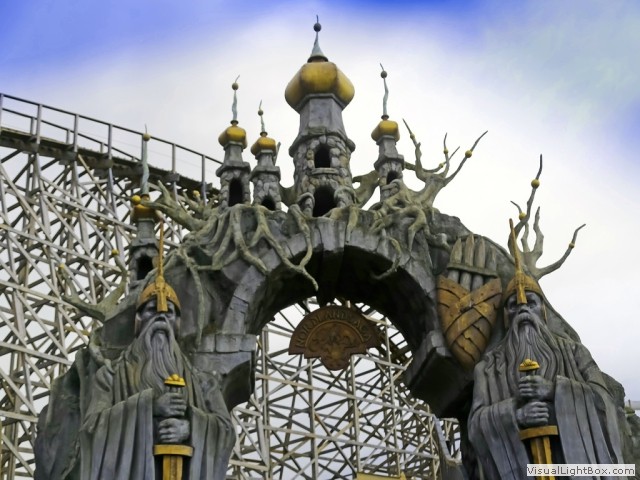 Europa-Park is the largest theme park in Germany, and the number two most popular
theme park resort in Europe, second only to Disneyland Paris. It’s located in the
German town of Rust, between Freiburg and Strasbourg. If you’ve been to any of
the famous theme parks they are much the same, but this had something missing,
I couldn’t quite put my finger on. It was only when I left Rust, I realised
what it was; it only sold German food, beer, and wine. Fine, when you’re in
Germany, but the themed country areas in Europa park were from all around
Europe. For example; I’d expect Spanish beer, and wine, and Tapas in the
Spain region. That said, the rides were exceptional and catered for all
ages, the roller coasters were death defying. Seriously, I absolutely mean that,
some say they’re the nearest thing to flying without wings. Whereas, I
say they’re the closest to a near death experience you’ll have, plunging
down one hundred metres with gravity dictating the speed. One would never
experience these G-forces in nature unless you threw yourself off a cliff.
Once the park shuts (1800) everyone runs for their cars in the massive car
parks and then it’s quiet. Rust village is probably a quarter of a mile
away from Europa park entrance. At 1900 you could stand on the kerb, close
your eyes, and randomly walk across the road (though I wouldn’t recommend
it) without fear of getting knocked over. The thing is, if it wasn’t on my route, I
would’ve never have even known about Europa park or the town of Rust
(it’s that unheard of), but it’s as good as any I’ve been to.
Europa-Park is the largest theme park in Germany, and the number two most popular
theme park resort in Europe, second only to Disneyland Paris. It’s located in the
German town of Rust, between Freiburg and Strasbourg. If you’ve been to any of
the famous theme parks they are much the same, but this had something missing,
I couldn’t quite put my finger on. It was only when I left Rust, I realised
what it was; it only sold German food, beer, and wine. Fine, when you’re in
Germany, but the themed country areas in Europa park were from all around
Europe. For example; I’d expect Spanish beer, and wine, and Tapas in the
Spain region. That said, the rides were exceptional and catered for all
ages, the roller coasters were death defying. Seriously, I absolutely mean that,
some say they’re the nearest thing to flying without wings. Whereas, I
say they’re the closest to a near death experience you’ll have, plunging
down one hundred metres with gravity dictating the speed. One would never
experience these G-forces in nature unless you threw yourself off a cliff.
Once the park shuts (1800) everyone runs for their cars in the massive car
parks and then it’s quiet. Rust village is probably a quarter of a mile
away from Europa park entrance. At 1900 you could stand on the kerb, close
your eyes, and randomly walk across the road (though I wouldn’t recommend
it) without fear of getting knocked over. The thing is, if it wasn’t on my route, I
would’ve never have even known about Europa park or the town of Rust
(it’s that unheard of), but it’s as good as any I’ve been to.
Day 7- Rust to Strasbourg airport (25 miles)
Today I was going home, so it was supposed to be the train (a few miles from
Rust) from Ringsheim to Offenburg to Strasbourg (France), then to Strasbourg
airport to fly home to Cardiff. However, when I rode to Ringsheim the ticket
machine said my journey was unavailable. I caught the train to Offenburg then
went to the ticket office, to cut the story short; the French were preventing
the German train crossing the Rhine into France (due to a strike). So the
options- catch the train to Kehl (on the German border) and ride across the
border (not feasible as it would too late for airport check-in), or ride from
Offenburg to Strasbourg airport (could be done if I start now). I was lucky
this was a cycling holiday and I had my fold-up bike with me. It wasn’t long
before I was riding along a pleasant forest country road. After a few miles
I turned onto a main road with a separate cycle path, it was really quite
nice. I crossed the ‘Pierre Pflimlin Bridge’ with views of the hydroelectric
power plant (which I can’t find the name of), then onto forest roads again,
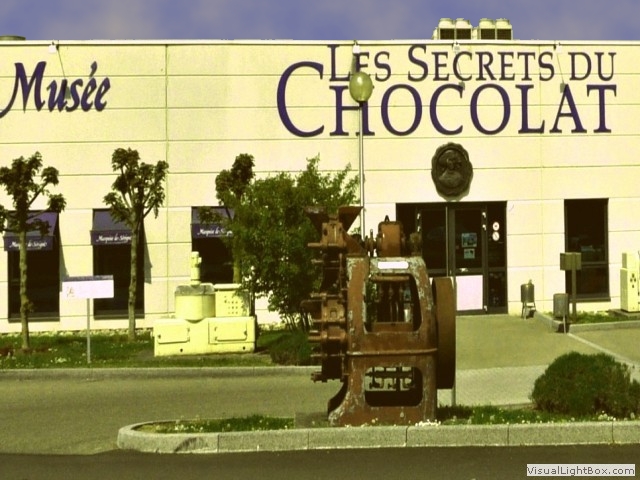 only now in France. Imagine my frustration when I passed a sign for ‘Les
Secrets du chocolat musee’ (a museum devoted to the subject of chocolate),
now this was torture. I put up with the French making me cycle to the
airport, but putting a chocolate museum on route (that I didn’t have
time to visit) was just unbearable. I arrived at the airport at 1230,
still in my cycling clothes, sweaty and quite likely very smelly. The
checkin desk nearly had a fit when I wheeled the bike to the desk, but
then explained I have to take it apart first. Once the bike had gone I
made my way to the toilets to change and throw some water on me (the duty
free is always useful in these circumstances; for splashing some gratis perfume all over).
only now in France. Imagine my frustration when I passed a sign for ‘Les
Secrets du chocolat musee’ (a museum devoted to the subject of chocolate),
now this was torture. I put up with the French making me cycle to the
airport, but putting a chocolate museum on route (that I didn’t have
time to visit) was just unbearable. I arrived at the airport at 1230,
still in my cycling clothes, sweaty and quite likely very smelly. The
checkin desk nearly had a fit when I wheeled the bike to the desk, but
then explained I have to take it apart first. Once the bike had gone I
made my way to the toilets to change and throw some water on me (the duty
free is always useful in these circumstances; for splashing some gratis perfume all over).
The whole point of riding the Rhine was to keep the route flat, well on that point, it was a complete success. However; I really didn’t think it would be as mind numbing, and tedious as it was. There were some great medieval towns along the way and they were incredible, so maybe I should have ridden from town to town. Europa park was fantastic, but many of the massive themes parks are much the same. Despite the diversions, it was kinda was fun, and with the invent of smart phones of today, it’s easy finding alternative directions or substitute transport options, it really was a piece of cake. I thought the mileage would be an issue, but again it was undemanding. The weather was a pain, I got completely soaked on two days, and though I took sun cream with me- I needn’t have bothered, it was overcast all week. The folding bike worked a treat and will almost certainly be centre of some other European trips, the downside of that is it doesn’t have the low gears of my other bike. On the whole it was a good trip, I met some nice people, and the Swiss, Germans, and French, put me to shame by speaking perfect English. Will I go back? Probably not the same route, though I think I’d like to explore Switzerland more.
-
Gallery
 Why not have a look at the gallery relating to this ride. Click the image or the title.
Why not have a look at the gallery relating to this ride. Click the image or the title. -
Zürich Skymetro
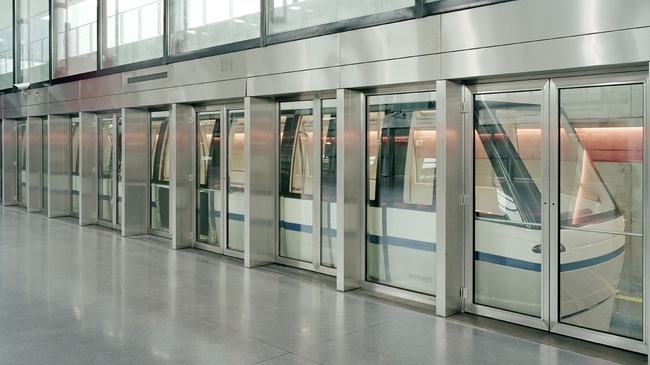 There was a long walk once we’d left the aircraft and then down escalators to an
underground station- Skymetro. From here it was about ten minutes to the baggage carousels.
There was a long walk once we’d left the aircraft and then down escalators to an
underground station- Skymetro. From here it was about ten minutes to the baggage carousels. -
Damaged baggage
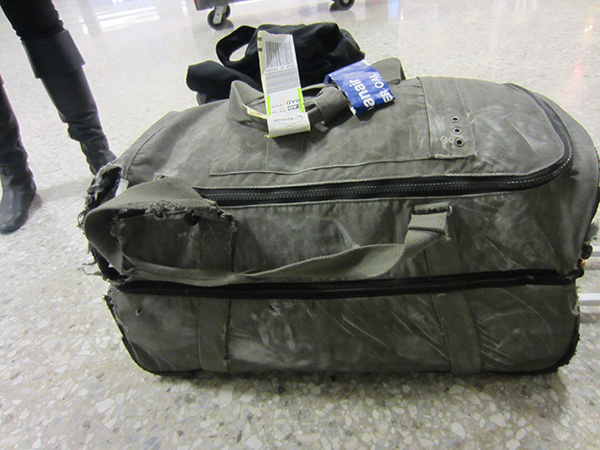 According to a well known travel blog, the airline usualy declines to pay for damage caused by the
fragile nature of the contents or inadequate packing, rather than the airline’s rough handling.
According to a well known travel blog, the airline usualy declines to pay for damage caused by the
fragile nature of the contents or inadequate packing, rather than the airline’s rough handling. -
Lindt chocolate factory
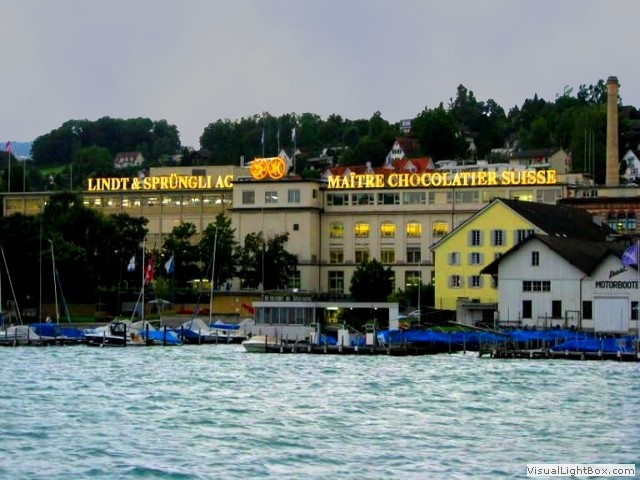 Switzerland is famous for its chocolate and legendary Swiss chocolatier ‘Lindt &
Sprungli’ have been churning out delicious confections since 1845. Today, visiting the
chocolate factory shop is a must for any chocolate lover.
Switzerland is famous for its chocolate and legendary Swiss chocolatier ‘Lindt &
Sprungli’ have been churning out delicious confections since 1845. Today, visiting the
chocolate factory shop is a must for any chocolate lover. -
Stadt Zürich and the Kaiser
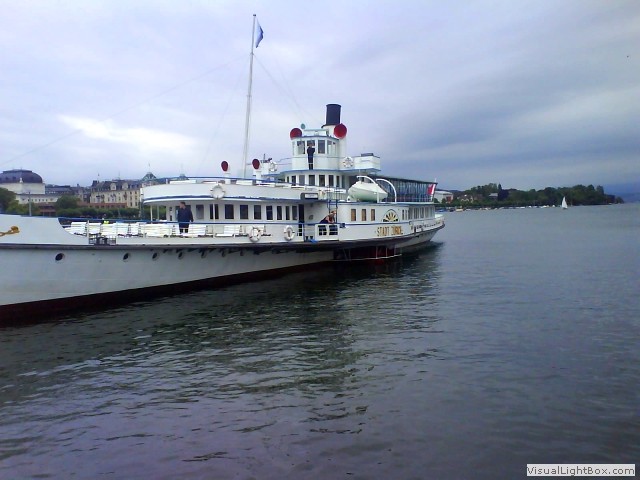 In September 1912 Stadt Zürich made an evening tour with her most famous guest
yet, the German Emperor Wilhelm II, and his blue-blooded retinue and few hand-picked
guests toured around the lake on a state visit.
In September 1912 Stadt Zürich made an evening tour with her most famous guest
yet, the German Emperor Wilhelm II, and his blue-blooded retinue and few hand-picked
guests toured around the lake on a state visit. -
Wettingen wooden bridge
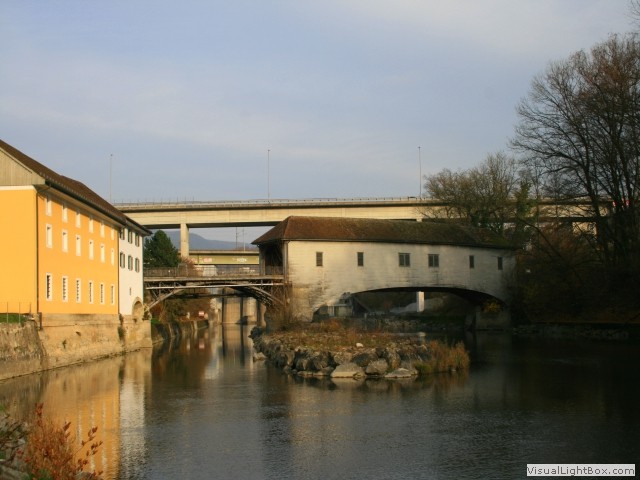 On a small spit of land at Wettingen was a Cistercian monastery, it was founded in
1227 and in 1841 was abolished by the canton of Aargau. The wooden bridge was built
to allow the monks passage to the customs house in Neuenhof.
On a small spit of land at Wettingen was a Cistercian monastery, it was founded in
1227 and in 1841 was abolished by the canton of Aargau. The wooden bridge was built
to allow the monks passage to the customs house in Neuenhof. -
Baden town
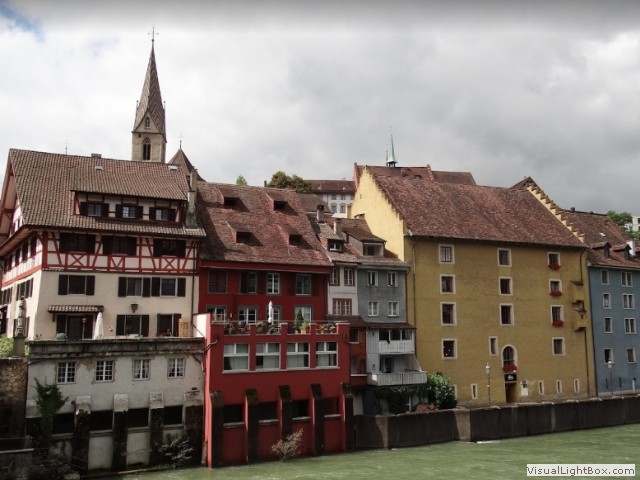 Baden has a Roman city, the ruins of castle Stein and is home to a number of other
Swiss Heritage Sites. The industrial sites include the ABB Schweiz archive along with
the former offices of ‘Brown Boveri’ a World famous electrical equipment (and train) supplier.
Baden has a Roman city, the ruins of castle Stein and is home to a number of other
Swiss Heritage Sites. The industrial sites include the ABB Schweiz archive along with
the former offices of ‘Brown Boveri’ a World famous electrical equipment (and train) supplier. -
Schweizerisches Militärmuseum Full
 Unbelievably this incredible museum was created by a single person; founded by 'Thomas
Hug' and friends. The sponsorship changed in 2004 and was supported by the Association
Military and Fortress Museum Full-Reuenthal (VMFM) opening a new hall with more exhibits.
Unbelievably this incredible museum was created by a single person; founded by 'Thomas
Hug' and friends. The sponsorship changed in 2004 and was supported by the Association
Military and Fortress Museum Full-Reuenthal (VMFM) opening a new hall with more exhibits. -
Bad Säckingen bridge
 The bridge was built in 1272 and was destroyed several times. The current bridge
was completed in 1700. It connects the German city of Bad Säckingen with the Swiss
village of Stein. Notice the boundary line in the image which marks the border of
Germany and Switzerland.
The bridge was built in 1272 and was destroyed several times. The current bridge
was completed in 1700. It connects the German city of Bad Säckingen with the Swiss
village of Stein. Notice the boundary line in the image which marks the border of
Germany and Switzerland. -
Schloss Beuggen
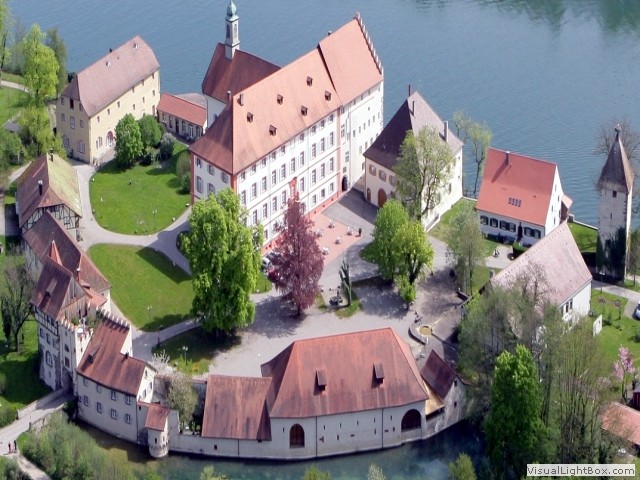 The origins of Beuggen are dark, but its believed to be founded around 1246, it was later completed
by the ‘German Order of Knights’. It had many uses; during the Napoleonic Wars, the
castle was declared a field hospital of the Austrian army and in the mid 1800’s it was
a children’s home. Only renovated in 2017 it is now a hotel.
The origins of Beuggen are dark, but its believed to be founded around 1246, it was later completed
by the ‘German Order of Knights’. It had many uses; during the Napoleonic Wars, the
castle was declared a field hospital of the Austrian army and in the mid 1800’s it was
a children’s home. Only renovated in 2017 it is now a hotel. -
Basel
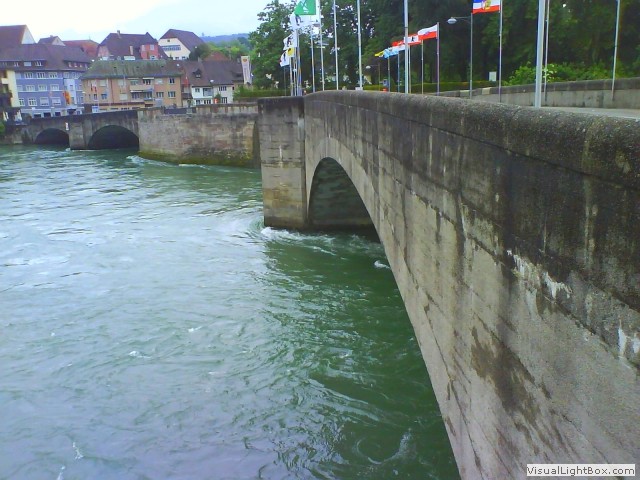 Basel is located where the Swiss, French, and German borders meet, known for its many
internationally renowned museums. It’s prominent for having one of the highest standards
of living in the World.
Basel is located where the Swiss, French, and German borders meet, known for its many
internationally renowned museums. It’s prominent for having one of the highest standards
of living in the World. -
Neuenburg am Rhein water sculptures
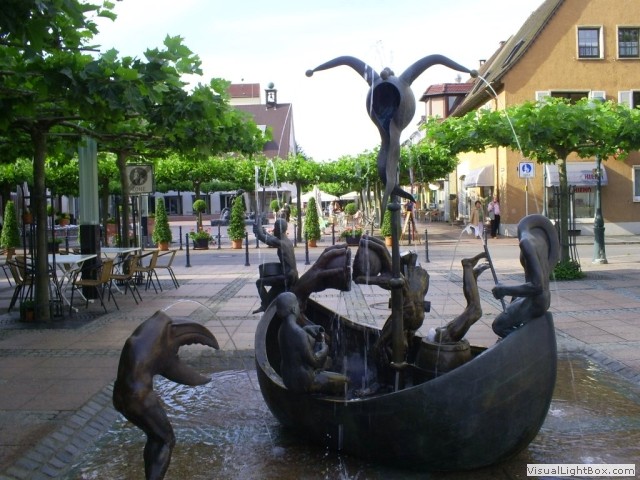 A fountain walk tour of the town centre takes you on a journey of discovery of
the town’s history. There are eleven different water features depicting life in
the town with people who contributed to its current well being.
A fountain walk tour of the town centre takes you on a journey of discovery of
the town’s history. There are eleven different water features depicting life in
the town with people who contributed to its current well being. -
The new ICE 4 trains
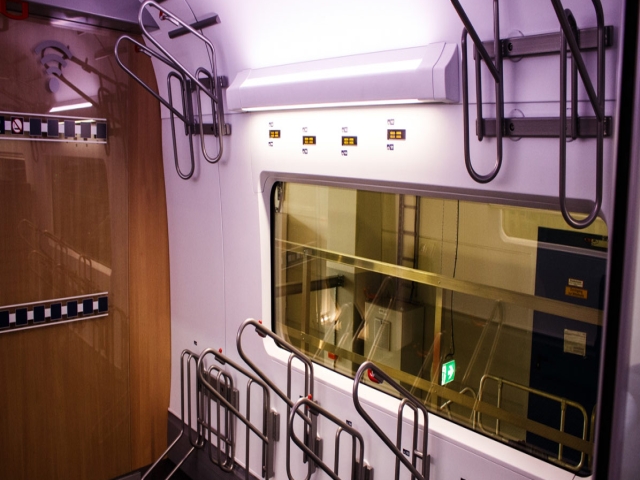 The brand new UK GWR trains boast- ‘Step on board, and enjoy more space,
more comfort, and faster journeys’. Yet Germany’s brand new train; the ICE 4
(Inter City Express) has set the latest standards on high speed services providing
carriage of eight assembled bicycles at each end, with two trains joined that’s quadruple the bikes
the new UK trains can carry.
The brand new UK GWR trains boast- ‘Step on board, and enjoy more space,
more comfort, and faster journeys’. Yet Germany’s brand new train; the ICE 4
(Inter City Express) has set the latest standards on high speed services providing
carriage of eight assembled bicycles at each end, with two trains joined that’s quadruple the bikes
the new UK trains can carry. -
Breisach
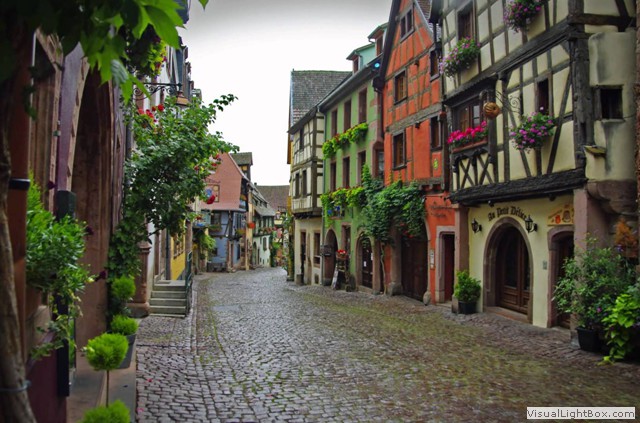 The town's landmark St. Stephen Cathedral, pastel-hued buildings,
and cobbled streets create an old-world charm that belies the fact that
the town was almost totally destroyed in WW2 and meticulously rebuilt in
the old style.
The town's landmark St. Stephen Cathedral, pastel-hued buildings,
and cobbled streets create an old-world charm that belies the fact that
the town was almost totally destroyed in WW2 and meticulously rebuilt in
the old style. -
Trulantica is born
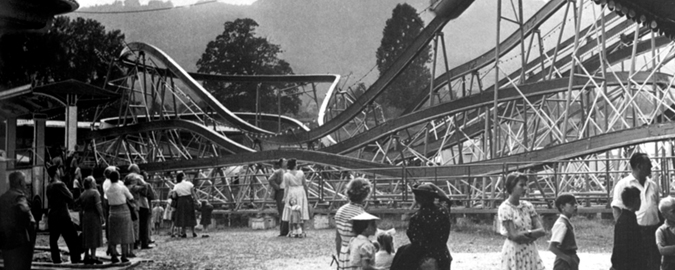 At the beginning, ‘Rust’ was never considered for the site of ‘Europapark’.
There was a piece of land by a small artificial lake called ‘Europa- Weiher’ just
south of Breisach. The town initially seemed perfect for the plans, but despite the
advanced preparations and numerous permits having been put in place, the project
fell through because of an objection from the ‘Federal Waterways and Shipping
Administration’, which had its own plans for the land.
At the beginning, ‘Rust’ was never considered for the site of ‘Europapark’.
There was a piece of land by a small artificial lake called ‘Europa- Weiher’ just
south of Breisach. The town initially seemed perfect for the plans, but despite the
advanced preparations and numerous permits having been put in place, the project
fell through because of an objection from the ‘Federal Waterways and Shipping
Administration’, which had its own plans for the land.
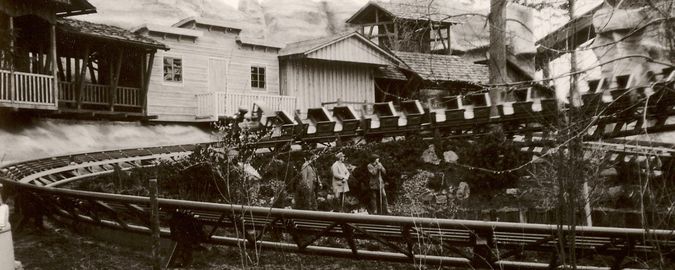 By 1915 the ‘Mack Rides.Co’ was already ‘purveyor to the court’ of Circus Krone; in
1921 it created the first rollercoaster. From 1930 onwards the family business
specialised in circus trucks, carrousels, ghost trains, and rollercoaster’s. In
1951 the Mack Company built the first bobsleigh run out of wood. Under the leadership
of Franz Mack and his sons Europa park was founded in Rust in 1974.
By 1915 the ‘Mack Rides.Co’ was already ‘purveyor to the court’ of Circus Krone; in
1921 it created the first rollercoaster. From 1930 onwards the family business
specialised in circus trucks, carrousels, ghost trains, and rollercoaster’s. In
1951 the Mack Company built the first bobsleigh run out of wood. Under the leadership
of Franz Mack and his sons Europa park was founded in Rust in 1974.
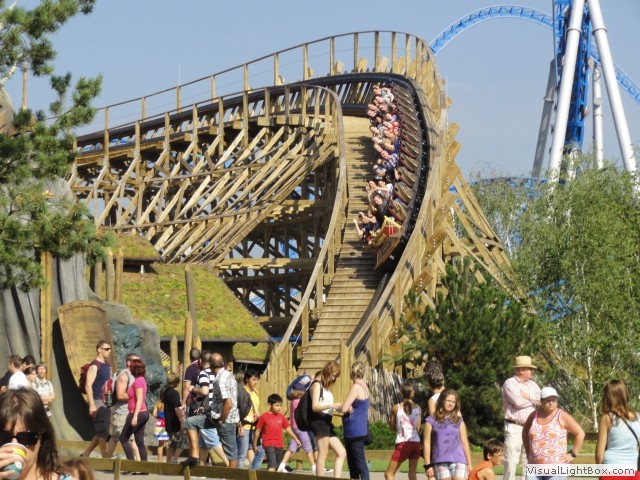 The park expanded every year, but took a leap forward building themed hotels
starting in 2004 with ‘El Andaluz’ (four other 4☆ hotels have been built since). In 2009 the
spectacular wooden rollercoaster ‘WODAN – Timburcoaster’ was completed, following
in the footsteps of its parent firm. The park is now home to 13 roller coasters and
hundreds of other rides. Europa-Park counted just over 5.6 million visitors
through its doors in 2017.
The park expanded every year, but took a leap forward building themed hotels
starting in 2004 with ‘El Andaluz’ (four other 4☆ hotels have been built since). In 2009 the
spectacular wooden rollercoaster ‘WODAN – Timburcoaster’ was completed, following
in the footsteps of its parent firm. The park is now home to 13 roller coasters and
hundreds of other rides. Europa-Park counted just over 5.6 million visitors
through its doors in 2017. -
The History of Chocolate
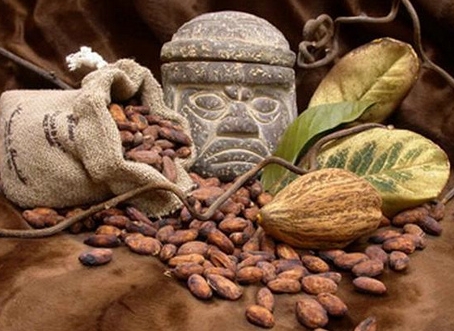 The Incas, Mayan, and Aztec civilization is believed to be the birthplace of Chocolate. The
Mayans of Central America are believed to be the first to discover cocoa as early
as 900 AD. In fact, the word ‘chocolate’ is said to come from the Mayan word
‘xocolatl’ which means ‘bitter water’. They mixed ground cacao seeds with
various seasonings to make a spicy, frothy drink.
The Incas, Mayan, and Aztec civilization is believed to be the birthplace of Chocolate. The
Mayans of Central America are believed to be the first to discover cocoa as early
as 900 AD. In fact, the word ‘chocolate’ is said to come from the Mayan word
‘xocolatl’ which means ‘bitter water’. They mixed ground cacao seeds with
various seasonings to make a spicy, frothy drink. -
Are the French always on strike?
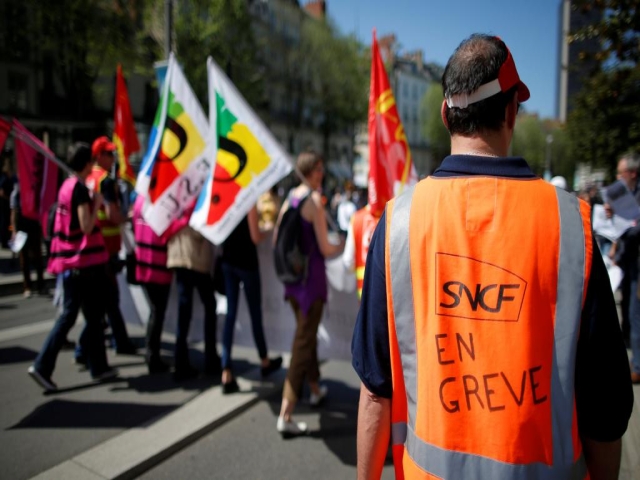 It may seem that way, and at least part of the industrial action of our Gallic
neighbours is because mass-participation in social action is in their DNA. 'The
telegraph ©' points out; French workers won the right to strike in
1864, 20 years before they were actually allowed to unionise. SNCF
(French national rail company) warned of ‘severe disruption’ for three
months starting in April 2018. Even dustmen, civil servants and public
utility workers had planned walkouts. Alarm bells should have rung in
the UK; when I tried to buy the Strasbourg ticket on the internet, it said it
was unavailable, but I knew the route existed. Oh well, ‘C'est la vie’. It
was just a misfortune I got caught in their strike on my last day.
It may seem that way, and at least part of the industrial action of our Gallic
neighbours is because mass-participation in social action is in their DNA. 'The
telegraph ©' points out; French workers won the right to strike in
1864, 20 years before they were actually allowed to unionise. SNCF
(French national rail company) warned of ‘severe disruption’ for three
months starting in April 2018. Even dustmen, civil servants and public
utility workers had planned walkouts. Alarm bells should have rung in
the UK; when I tried to buy the Strasbourg ticket on the internet, it said it
was unavailable, but I knew the route existed. Oh well, ‘C'est la vie’. It
was just a misfortune I got caught in their strike on my last day.

 There was a long walk once we’d left the aircraft and then down escalators to an
underground station- Skymetro. From here it was about ten minutes to the baggage carousels.
There was a long walk once we’d left the aircraft and then down escalators to an
underground station- Skymetro. From here it was about ten minutes to the baggage carousels. According to a well known travel blog, the airline usualy declines to pay for damage caused by the
fragile nature of the contents or inadequate packing, rather than the airline’s rough handling.
According to a well known travel blog, the airline usualy declines to pay for damage caused by the
fragile nature of the contents or inadequate packing, rather than the airline’s rough handling. Switzerland is famous for its chocolate and legendary Swiss chocolatier ‘Lindt &
Sprungli’ have been churning out delicious confections since 1845. Today, visiting the
chocolate factory shop is a must for any chocolate lover.
Switzerland is famous for its chocolate and legendary Swiss chocolatier ‘Lindt &
Sprungli’ have been churning out delicious confections since 1845. Today, visiting the
chocolate factory shop is a must for any chocolate lover. In September 1912 Stadt Zürich made an evening tour with her most famous guest
yet, the German Emperor Wilhelm II, and his blue-blooded retinue and few hand-picked
guests toured around the lake on a state visit.
In September 1912 Stadt Zürich made an evening tour with her most famous guest
yet, the German Emperor Wilhelm II, and his blue-blooded retinue and few hand-picked
guests toured around the lake on a state visit. On a small spit of land at Wettingen was a Cistercian monastery, it was founded in
1227 and in 1841 was abolished by the canton of Aargau. The wooden bridge was built
to allow the monks passage to the customs house in Neuenhof.
On a small spit of land at Wettingen was a Cistercian monastery, it was founded in
1227 and in 1841 was abolished by the canton of Aargau. The wooden bridge was built
to allow the monks passage to the customs house in Neuenhof. Baden has a Roman city, the ruins of castle Stein and is home to a number of other
Swiss Heritage Sites. The industrial sites include the ABB Schweiz archive along with
the former offices of ‘Brown Boveri’ a World famous electrical equipment (and train) supplier.
Baden has a Roman city, the ruins of castle Stein and is home to a number of other
Swiss Heritage Sites. The industrial sites include the ABB Schweiz archive along with
the former offices of ‘Brown Boveri’ a World famous electrical equipment (and train) supplier. Unbelievably this incredible museum was created by a single person; founded by 'Thomas
Hug' and friends. The sponsorship changed in 2004 and was supported by the Association
Military and Fortress Museum Full-Reuenthal (VMFM) opening a new hall with more exhibits.
Unbelievably this incredible museum was created by a single person; founded by 'Thomas
Hug' and friends. The sponsorship changed in 2004 and was supported by the Association
Military and Fortress Museum Full-Reuenthal (VMFM) opening a new hall with more exhibits.  The bridge was built in 1272 and was destroyed several times. The current bridge
was completed in 1700. It connects the German city of Bad Säckingen with the Swiss
village of Stein. Notice the boundary line in the image which marks the border of
Germany and Switzerland.
The bridge was built in 1272 and was destroyed several times. The current bridge
was completed in 1700. It connects the German city of Bad Säckingen with the Swiss
village of Stein. Notice the boundary line in the image which marks the border of
Germany and Switzerland. The origins of Beuggen are dark, but its believed to be founded around 1246, it was later completed
by the ‘German Order of Knights’. It had many uses; during the Napoleonic Wars, the
castle was declared a field hospital of the Austrian army and in the mid 1800’s it was
a children’s home. Only renovated in 2017 it is now a hotel.
The origins of Beuggen are dark, but its believed to be founded around 1246, it was later completed
by the ‘German Order of Knights’. It had many uses; during the Napoleonic Wars, the
castle was declared a field hospital of the Austrian army and in the mid 1800’s it was
a children’s home. Only renovated in 2017 it is now a hotel. Basel is located where the Swiss, French, and German borders meet, known for its many
internationally renowned museums. It’s prominent for having one of the highest standards
of living in the World.
Basel is located where the Swiss, French, and German borders meet, known for its many
internationally renowned museums. It’s prominent for having one of the highest standards
of living in the World. A fountain walk tour of the town centre takes you on a journey of discovery of
the town’s history. There are eleven different water features depicting life in
the town with people who contributed to its current well being.
A fountain walk tour of the town centre takes you on a journey of discovery of
the town’s history. There are eleven different water features depicting life in
the town with people who contributed to its current well being.  The brand new UK GWR trains boast- ‘Step on board, and enjoy more space,
more comfort, and faster journeys’. Yet Germany’s brand new train; the ICE 4
(Inter City Express) has set the latest standards on high speed services providing
carriage of eight assembled bicycles at each end, with two trains joined that’s quadruple the bikes
the new UK trains can carry.
The brand new UK GWR trains boast- ‘Step on board, and enjoy more space,
more comfort, and faster journeys’. Yet Germany’s brand new train; the ICE 4
(Inter City Express) has set the latest standards on high speed services providing
carriage of eight assembled bicycles at each end, with two trains joined that’s quadruple the bikes
the new UK trains can carry. The town's landmark St. Stephen Cathedral, pastel-hued buildings,
and cobbled streets create an old-world charm that belies the fact that
the town was almost totally destroyed in WW2 and meticulously rebuilt in
the old style.
The town's landmark St. Stephen Cathedral, pastel-hued buildings,
and cobbled streets create an old-world charm that belies the fact that
the town was almost totally destroyed in WW2 and meticulously rebuilt in
the old style. At the beginning, ‘Rust’ was never considered for the site of ‘Europapark’.
There was a piece of land by a small artificial lake called ‘Europa- Weiher’ just
south of Breisach. The town initially seemed perfect for the plans, but despite the
advanced preparations and numerous permits having been put in place, the project
fell through because of an objection from the ‘Federal Waterways and Shipping
Administration’, which had its own plans for the land.
At the beginning, ‘Rust’ was never considered for the site of ‘Europapark’.
There was a piece of land by a small artificial lake called ‘Europa- Weiher’ just
south of Breisach. The town initially seemed perfect for the plans, but despite the
advanced preparations and numerous permits having been put in place, the project
fell through because of an objection from the ‘Federal Waterways and Shipping
Administration’, which had its own plans for the land. By 1915 the ‘Mack Rides.Co’ was already ‘purveyor to the court’ of Circus Krone; in
1921 it created the first rollercoaster. From 1930 onwards the family business
specialised in circus trucks, carrousels, ghost trains, and rollercoaster’s. In
1951 the Mack Company built the first bobsleigh run out of wood. Under the leadership
of Franz Mack and his sons Europa park was founded in Rust in 1974.
By 1915 the ‘Mack Rides.Co’ was already ‘purveyor to the court’ of Circus Krone; in
1921 it created the first rollercoaster. From 1930 onwards the family business
specialised in circus trucks, carrousels, ghost trains, and rollercoaster’s. In
1951 the Mack Company built the first bobsleigh run out of wood. Under the leadership
of Franz Mack and his sons Europa park was founded in Rust in 1974. The park expanded every year, but took a leap forward building themed hotels
starting in 2004 with ‘El Andaluz’ (four other 4☆ hotels have been built since). In 2009 the
spectacular wooden rollercoaster ‘WODAN – Timburcoaster’ was completed, following
in the footsteps of its parent firm. The park is now home to 13 roller coasters and
hundreds of other rides. Europa-Park counted just over 5.6 million visitors
through its doors in 2017.
The park expanded every year, but took a leap forward building themed hotels
starting in 2004 with ‘El Andaluz’ (four other 4☆ hotels have been built since). In 2009 the
spectacular wooden rollercoaster ‘WODAN – Timburcoaster’ was completed, following
in the footsteps of its parent firm. The park is now home to 13 roller coasters and
hundreds of other rides. Europa-Park counted just over 5.6 million visitors
through its doors in 2017.  The Incas, Mayan, and Aztec civilization is believed to be the birthplace of Chocolate. The
Mayans of Central America are believed to be the first to discover cocoa as early
as 900 AD. In fact, the word ‘chocolate’ is said to come from the Mayan word
‘xocolatl’ which means ‘bitter water’. They mixed ground cacao seeds with
various seasonings to make a spicy, frothy drink.
The Incas, Mayan, and Aztec civilization is believed to be the birthplace of Chocolate. The
Mayans of Central America are believed to be the first to discover cocoa as early
as 900 AD. In fact, the word ‘chocolate’ is said to come from the Mayan word
‘xocolatl’ which means ‘bitter water’. They mixed ground cacao seeds with
various seasonings to make a spicy, frothy drink. It may seem that way, and at least part of the industrial action of our Gallic
neighbours is because mass-participation in social action is in their DNA. 'The
telegraph ©' points out; French workers won the right to strike in
1864, 20 years before they were actually allowed to unionise. SNCF
(French national rail company) warned of ‘severe disruption’ for three
months starting in April 2018. Even dustmen, civil servants and public
utility workers had planned walkouts. Alarm bells should have rung in
the UK; when I tried to buy the Strasbourg ticket on the internet, it said it
was unavailable, but I knew the route existed. Oh well, ‘C'est la vie’. It
was just a misfortune I got caught in their strike on my last day.
It may seem that way, and at least part of the industrial action of our Gallic
neighbours is because mass-participation in social action is in their DNA. 'The
telegraph ©' points out; French workers won the right to strike in
1864, 20 years before they were actually allowed to unionise. SNCF
(French national rail company) warned of ‘severe disruption’ for three
months starting in April 2018. Even dustmen, civil servants and public
utility workers had planned walkouts. Alarm bells should have rung in
the UK; when I tried to buy the Strasbourg ticket on the internet, it said it
was unavailable, but I knew the route existed. Oh well, ‘C'est la vie’. It
was just a misfortune I got caught in their strike on my last day.